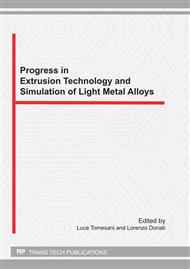p.151
p.159
p.173
p.181
p.189
p.197
p.205
p.215
p.223
Numerical and Experimental Study on Seam Welding Behavior in Extrusion of Micro-Channel Tube
Abstract:
Micro-channel tube with submillimeter-diameter channels is a kind of newly developed heat transfer tube based on theory of micro-scale heat transfer. As the micro-channel tube has multiple welding points and work under high pressure condition, welding strength is one of the key problems for the extrusion process. This paper presented a new method in evaluation of the seam welding strength formed in the extrusion process. Firstly, FE simulation is carried out for the status of the billet in the welding chamber during the extrusion process. Then, thermo mechanical experiment is done for the relationship between the welding strength and three key factors. Combining the relationship with the numerical results, welding strength of the micro-channel tube can be evaluated. Pressure bearing test shows that the evolution method is reliable. The study is helpful for the optimization the extrusion process and improvement of the seam weld quality.
Info:
Periodical:
Pages:
189-195
Citation:
Online since:
September 2011
Authors:
Keywords:
Price:
Сopyright:
© 2012 Trans Tech Publications Ltd. All Rights Reserved
Share:
Citation:


